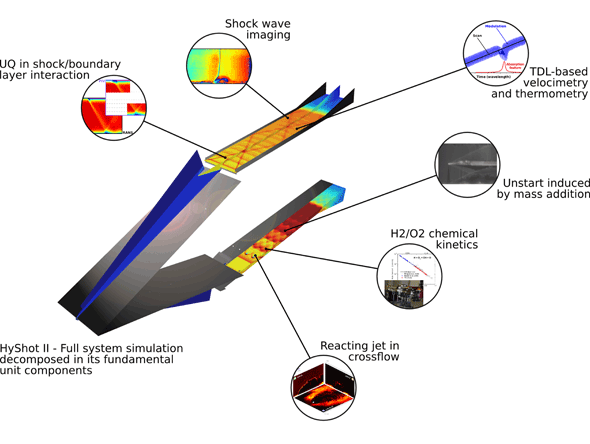| Supporting experiments |
| |
| Shock/boundary layer interaction with uncertain boundary conditions |
 |
The goal of this work is to investigate and quantify the sensitivity of shock wave/boundary layer interaction to changes in upstream boundary conditions. This experiment has been specifically designed with a UQ focus and is an integral part of the UQ efforts on shock dynamics modeling. Surface pressure and particle image velocimetry (PIV) measurements are carried in a continuous flow, Mach 2 wind tunnel under different inlet flow conditions. Well-controlled perturbations on an imposed ramp-generated impiging oblique shock are generated by a deformable wall.
[more...] | |
| |
| Inlet unstart induced by jet injection |
 |
This experiment is designed to provide an understanding of the fundamental physical processes that induce and drive the unstart process in supersonic ducted flows. Unstart is induced by mass addition through a transverse jet in crossflow within a Mach 5 wind tunnel. CO2 Mie scattering imaging of the shock structures leading to unstart and PIV measurements of the flow-field are carried out. Fast-response pressure transducers are also used to investigate the dynamics of the unstart process.
[more...] | |
| |
| H2/O2 chemical kinetics |
 |
The work is aimed at the development of a high-fidelity H2/O2 kinetic mechanism based on accurate reaction rate measurements using state-of-the-art, highly-accurate, H2O laser-absorption-based measurement techniques in shock tubes. The end goal is to develop a refined and improved H2/O2 kinetics mechanism with a solid understanding of the sources and levels of uncertainty in the proposed reaction rates, and their impact on the predictive capability of the combustion models.
[more...] | |
| |
| Imaging of shock wave flows |
 |
Planar laser-induced fluorescence based flow imaging techniques are being developed and implemented in order to visualize and quantitatively measure temperature in shock-dominated flows. This highly sensitive and accurate method uses toluene as a fluorescence tracer. This work is carried out in our shock tube facilities.
[more...] | |
| |
| Jet in crossflow experiment |
 |
A transverse hydrogen jet in a high-enthalpy supersonic crossflow is taken as unit problem to investigate mixing and combustion in the supersonic regime. The work is carried out in the Stanford Expansion Tube located at HTGL. High-speed Schlieren imaging and planar laser induced fluorescence of flow and combustion product tracers are used to investigate mixing, ignition and flame structure of this canonical flow under different injection parameters. This work is in direct support to the heat release modeling validation efforts.
[more...] | |
| |
| TDL-based velocimetry and thermometry development |
 |
This experimental activity aims at the development of tunable diode laser (TDL) -based, line-of-sight integrated, high-speed measurement techniques of velocity and temperature in hypersonic flows. This work is in support of the activities on supersonic mixing and combustion undergoing in the expansion tube facility. It will help us to better characterize the experiment conditions and, thus, reduce uncertainties.
[more...] | |
| |
| |

